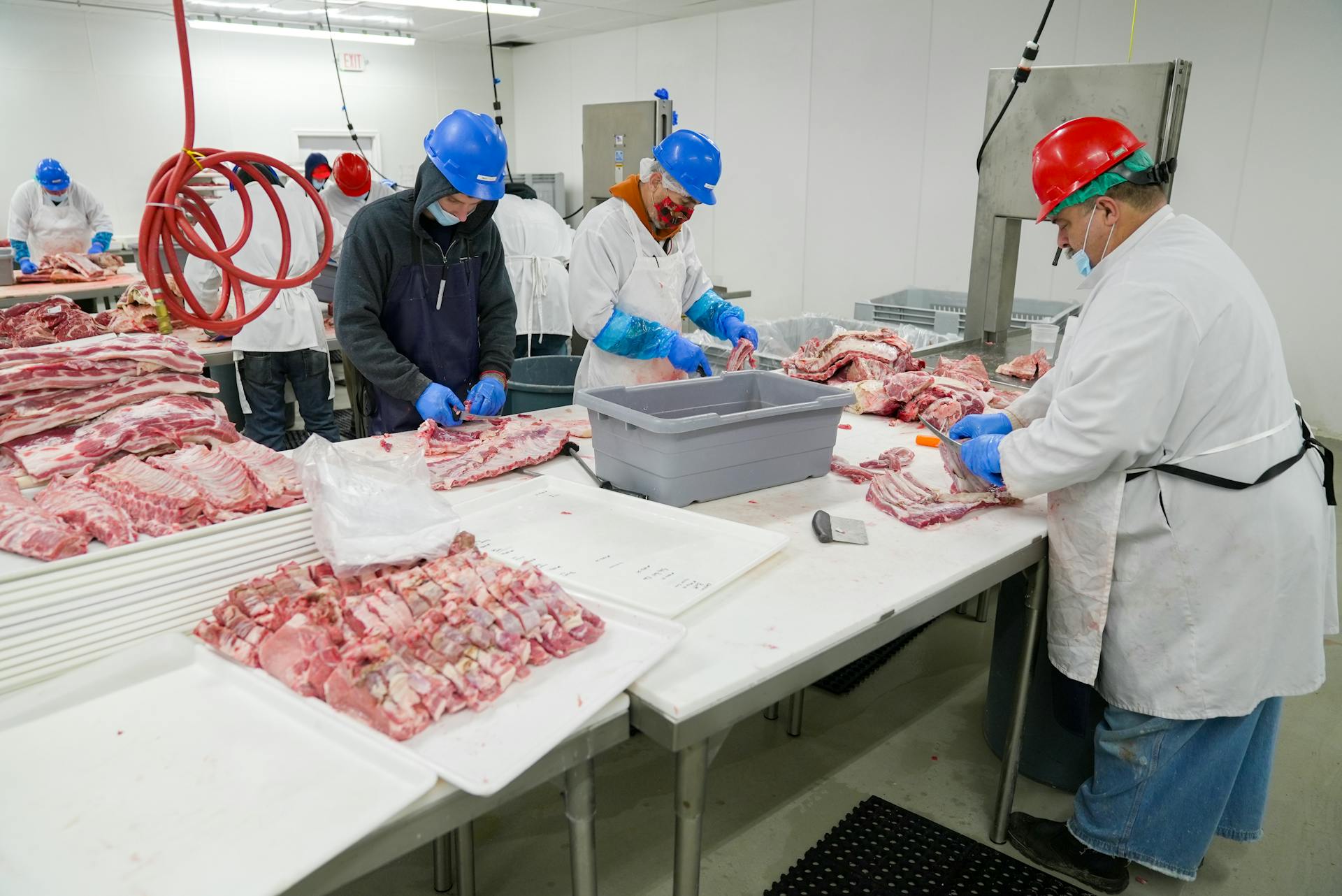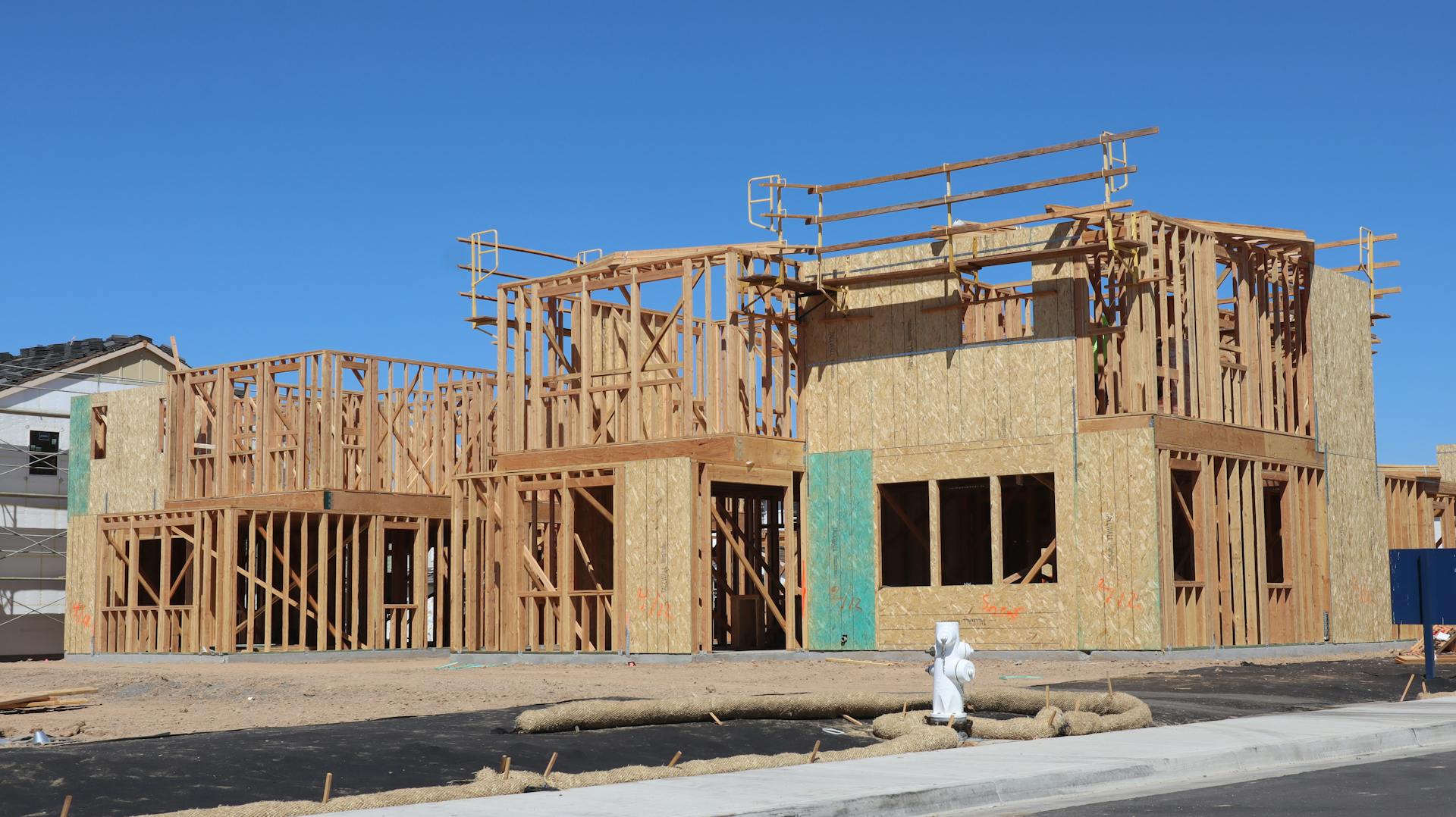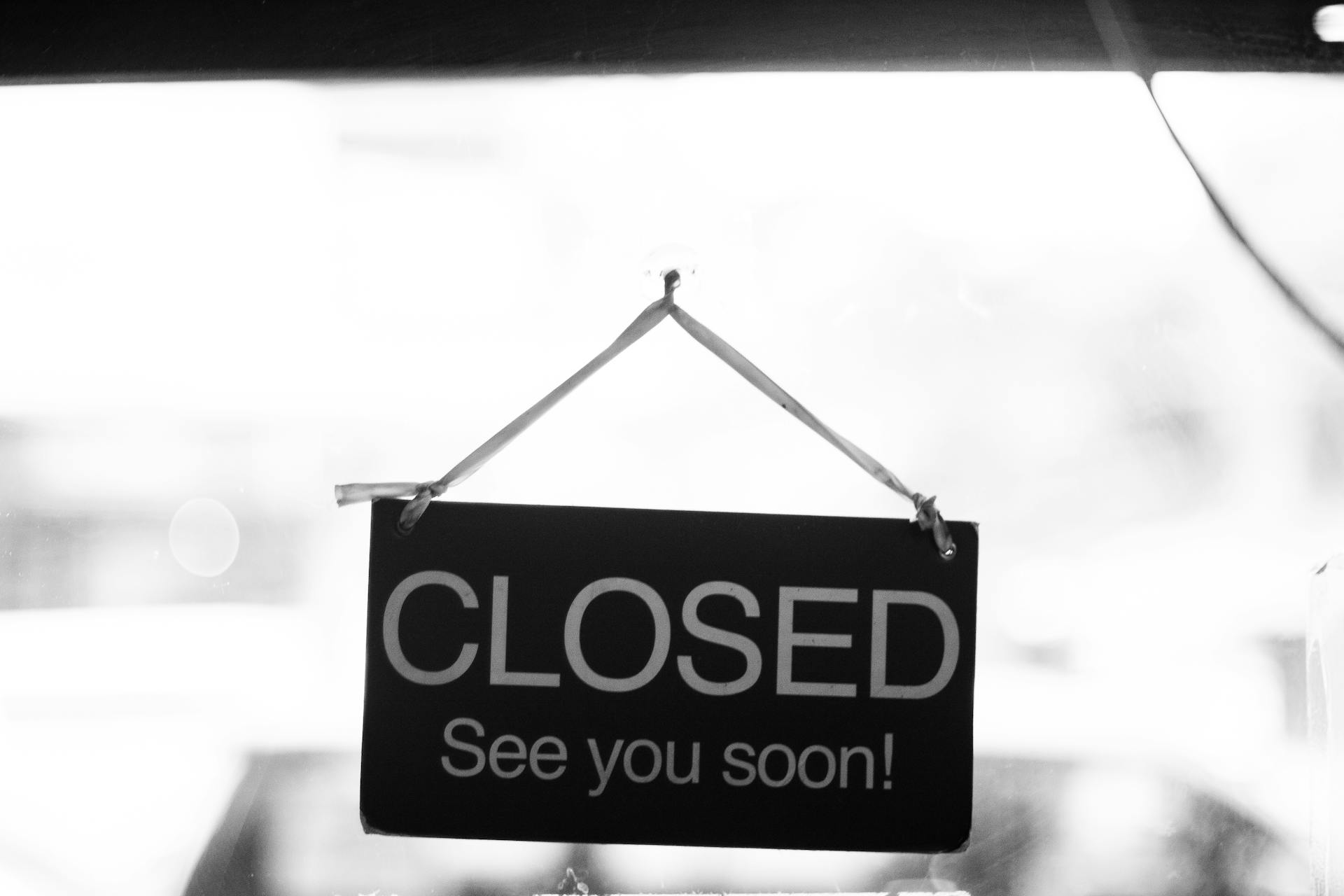
Closing costs for a USDA home loan can be a significant burden, but there are ways to save and finance them.
The average closing cost for a USDA home loan is around 2-5% of the purchase price, which can add up quickly.
You can save for closing costs by setting aside a portion of your monthly income each month, and consider opening a dedicated savings account to keep your funds separate.
A USDA home loan allows you to finance up to 100% of the home's purchase price, which means you can use the loan proceeds to cover closing costs.
Worth a look: Lawyer Fee for House Purchase
What is a USDA Home Loan?
A USDA Home Loan is a type of mortgage loan that's guaranteed by the United States Department of Agriculture.
It's designed to help low-to-moderate income borrowers purchase homes in rural areas, with benefits that include lower mortgage insurance premiums and more lenient credit score requirements.
These loans have a zero-down payment option, which can be a huge advantage for buyers who don't have a lot of savings.

USDA Home Loans are only available for homes in designated rural areas, which are defined by the USDA as areas outside of cities and towns with a population of 35,000 or less.
The USDA has a specific map that shows which areas qualify for these loans, and it's updated periodically to reflect changes in population and development.
Benefits
One of the biggest benefits of a USDA loan is that it requires no down payment, which can mean significant savings come closing day.
USDA loans also have a relatively flexible credit score requirement, with a 640 score being the minimum for automatic underwriting, but borrowers with lower scores can still be approved through a manual underwriting process.
Low interest rates are another advantage of USDA loans, made possible by the U.S. government's guarantee of the loans, even for borrowers with less-than-perfect credit scores.
USDA loans have lower mortgage insurance rates compared to other loan options, with a 1% upfront funding fee and 0.35% annual fee, which is lower than the 1.75% upfront and 0.80% to 1.05% annual fees paid by FHA borrowers.
Suggestion: Expense Ratio vs Management Fee
Closing Costs and Fees

Closing costs on a USDA loan can be a significant expense, but there are ways to reduce them. These costs cover standard mortgage closing costs and USDA loan-specific fees.
Standard mortgage closing costs include underwriting fees, loan origination fees, appraisal fees, credit report fees, title and recording fees, escrow fees, and discount points.
You'll also pay a 1% upfront guarantee fee unique to this loan program. This fee can usually be financed into your loan on top of what you're borrowing to purchase the home.
If you're not eligible to wrap your USDA loan closing costs into your mortgage, you can reduce your upfront expenses by using gift funds. Approved family, relatives, and friends can provide cash gifts that may be used toward your upfront homebuying expenses.
Here are some loan-related expenses to expect when closing on a USDA loan:
To use gift funds, your lender will require verification that the money is in fact a gift, rather than a loan that needs to be paid back.
Home Financing Options

Homebuyers can explore various home financing options to cover closing costs on a USDA home loan. Borrowers must meet specific requirements, including being a U.S. citizen or qualified alien, occupying the home as their primary residence, and having an income that's 115% or less than the median household income in the area.
USDA guaranteed loans offer favorable interest rates and easier qualifying requirements, with no down payment required. However, borrowers are still responsible for paying closing costs, which typically range from 2% to 5% of the total purchase price.
To cover these costs, homebuyers can consider the following options:
- Seller concessions: Sellers can contribute up to 6% of the purchase price toward closing costs and concessions.
- Lender credit: Lenders may offer to pay for some or all of the closing costs in exchange for a higher interest rate on the USDA loan.
- Financing: In some cases, borrowers can finance certain USDA closing costs, such as the upfront guarantee fee, into their loan.
What Is a Mortgage?
A mortgage is a type of loan that allows you to borrow money to purchase a home. It's a significant financial commitment, but understanding how it works can help you make informed decisions.
The government offers mortgage options that can make homeownership more accessible, such as the USDA mortgage loan. This program provides benefits like 100% financing options and lenient credit requirements.
USDA mortgage loans are designed for low to average-income borrowers and offer low, fixed-interest rates. This can be a big advantage for those who might not qualify for other loan programs.
The USDA mortgage loan can be used for purchases, refinances, and renovations.
Return on Investment

When considering a home loan, it's essential to think about the Return on Investment (ROI). A 30-year mortgage can save you thousands of dollars in interest payments compared to a 15-year mortgage. The difference in interest paid between the two is substantial, with a 30-year mortgage paying up to $100,000 more in interest over the life of the loan.
However, a 30-year mortgage can also provide lower monthly payments, making it more manageable for some homeowners. For example, a $200,000 loan at 4% interest would have a monthly payment of around $955.
You might like: Interest Only Home Mortgage Loans
Home Financing Options
If you're looking for home financing options, you're in luck because there are several to choose from. One popular option is the USDA loan, which offers zero down payment and favorable interest rates.
To qualify for a USDA loan, you'll need to meet certain income requirements, which vary by area but are currently $112,450 or less for most parts of the country. You'll also need to occupy the home as your primary residence and demonstrate a willingness and ability to repay the debt.

USDA loans are issued through USDA-approved mortgage lenders and come with various fees and closing costs, which can range from 2% to 5% of the total purchase price. This can add up to around $4,000 to $10,000 on a $200,000 home.
You may be able to roll some of these costs into your loan balance and spread them out over time. In some cases, you can also ask the seller to cover some or all of your upfront expenses, up to 6% of the total sales price.
Here are some ways to cover closing costs on a USDA mortgage loan:
- Get the seller to pay them, especially if the property has been on the market for a while or isn't getting many showings.
- Lender credits: Agree to pay a slightly higher interest rate for your loan, which can build lender credits that can be used for closing costs.
- Use a gift of money from a family member or close friend to help cover closing costs.
Home Prices
Home prices vary depending on the location, with USDA loans available for homes in rural areas that are priced affordably, typically below the median home price in the area.
Closing costs for a USDA loan can range from 2% to 6% of the loan amount, which is a relatively standard range for most loan programs.

The USDA loan program is designed to help low-to-moderate income borrowers purchase homes in rural areas, where home prices are often lower than in urban areas.
In some cases, home prices in rural areas may be significantly lower than in urban areas, making it easier for buyers to qualify for a USDA loan.
Consider reading: Usda Rural Home Loan Oregon
Property-Related
When buying a home, property-related costs can add up quickly. Property taxes, for instance, are an upfront payment for a specified period, typically 1% of the property value.
You'll also need to consider homeowners insurance, which usually requires a first-year premium payment of $800 to $1,500.
Recording fees are another cost to factor in – a one-time payment of $300 to officially record the change of property ownership and the mortgage on public record.
If you're buying a home in a neighborhood with a Homeowners Association (HOA), you may need to pay HOA fees upfront, which can vary in cost.
A fresh viewpoint: Usda Mortgage down Payment

Home warranties, while not required, can provide peace of mind and cover a range of house-related costs not covered by your homeowners insurance, typically costing between $300 and $500.
Here's a breakdown of these property-related costs:
Check Your Eligibility for $0 Down
To check your eligibility for a $0 Down USDA Loan, you can connect with a trusted USDA lender.
You can also check your USDA eligibility with a USDA loan specialist.
Some state housing authorities and non-profit organizations offer grants or assistance programs for first-time homebuyers or low-to-moderate-income buyers that can be applied toward closing costs.
You can speak with your lender about the availability of assistance options along with any requirements or limitations that may apply.
Local or state housing authorities should be able to provide some information on state-level offerings, but be sure to research what’s available in your city or county as well.
There are many assistance programs out there to help worthy borrowers purchase homes.
Take a look at this: Tepezza Copay Assistance
Home Prices and Financing

The median household income in most areas of the country is $112,450, which is the maximum income to qualify for a USDA loan.
To qualify for a USDA loan, you must have an income that's 115% or less than the median household income in the area.
USDA loans allow you to put no down payment, but you must occupy the home as your primary residence.
The USDA guarantees these loans, which means it will repay the lender if you fail to pay back the loan, allowing lenders to offer more favorable interest rates.
To qualify for a USDA loan, you must have a debt-to-income ratio of 41% or less.
If you're unable to negotiate for seller or lender credits, you'll need to find an alternative method to pay for USDA closing costs upfront.
Some lenders may offer to pay for some or all of your closing costs in exchange for a higher interest rate on your USDA loan.
A fresh viewpoint: Cost for Companies to Offer Health Insurance
Frequently Asked Questions
Do USDA loans take longer to close?
Yes, USDA loans may take longer to close due to additional requirements, such as a USDA appraisal and approval by the USDA Rural Development Office. This can add time to the underwriting process, but the exact timeline varies on a case-by-case basis.
How much is the USDA upfront fee?
The USDA upfront fee is 1.00% of the home's sales price. This fee is a one-time payment required for USDA mortgage insurance.
Sources
- https://crosscountrymortgage.com/mortgage/loans/usda-loans/
- https://www.mortgageresearch.com/guides/guide-to-usda-loans/
- https://migonline.com/blog/2022/08/13/usda-loan-closing-costs-can-they-be-rolled-into-your-loan/
- https://www.fairway.com/articles/usda-loan-closing-costs-how-much-youll-pay-and-how-to-lower-your-upfront-fees
- https://www.usdaloans.com/articles/usda-loan-closing-costs/
Featured Images: pexels.com


